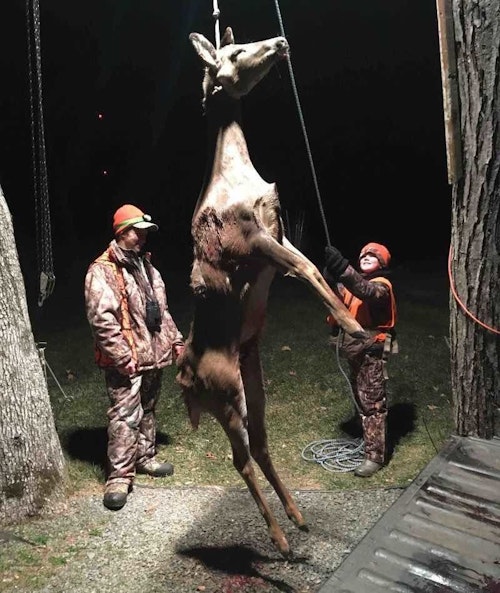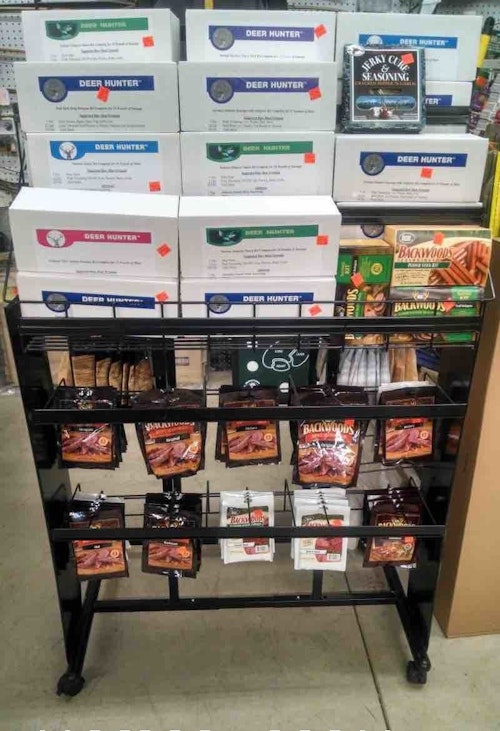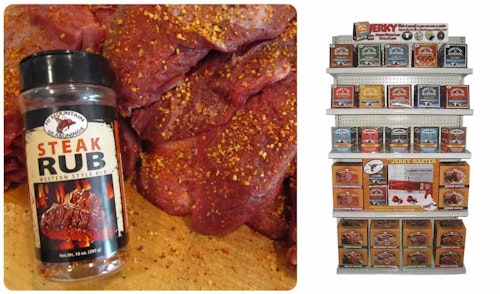Pro shop owners, at least the more entrepreneurial ones, continually look for ways to increase sales, but too often fail to see the big picture, or “think outside the box” as they say in business lingo. They stock the latest, greatest in bows and broadheads, sights and rests, and maybe scents and lures, camo apparel and trail cameras. All these items are intended to help hunters reduce their quarry to possession. However, beyond a knife for field dressing and maybe a registration station, the help and the sales stop there, and customers are on their own to finish the process — and the game processing.
People hunt for various reasons, but surveys show that acquiring organic protein is at or near the top of most lists. That niche is only growing with increased popularity of locavory and self-sufficiency. Wildlife biologists have a riddle: What do you do with a niche? A: You scratch it. By providing hunters with the supplies they need after the kill, shop owners could increase their customer base and margins, sometimes significantly.
Ray Weasner owns and operates Weasner Archery in Bloomville, Ohio. Weasner is a prolific and proficient processor of game, turning venison into all matter of edibles including sausage, bologna, snack sticks and jerky. What started as a casual value-added service very quickly turned into a sales boom. During and after the hunting season, he put out samples at the counter for his customers. The light came on for him when they began asking questions about how they could make their own and what they needed to do it.
Ray recognized an opportunity and started stocking venison processing supplies in his store. “What better place to have it?” he said. “A lot of bowhunters do their own processing. If they know you have it, they’re going to pick it up locally rather than order it online.” Having a sales representative on hand to explain game processing and, in some cases demonstrate product use, is a value-added service your customers will appreciate.
The benefits are obvious. More products attract more customers and drive more sales. By offering post-hunt or post-season products, shop owners can widen their sales window. They’re also providing customers with an economic benefit.
“When they find out they can do it for a whole lot less than a processor, they really get interested,” Weasner said. “Even if you shoot only one deer a year, it’s still worth the investment.”
That’s especially true now with a recent increase in license sales and success rates that has overwhelmed commercial processors, in some cases prompting them to turn away customers. The average cost for processing a deer is around $100. Even if your customer drops off only one deer per year for processing, they can easily recoup the costs for basic tools in a couple seasons by doing it themselves. If they do more, the savings comes more quickly.
There are also a philosophical and practical benefits. Processing a deer is often a family or social activity, and a great deal of satisfaction can be derived from doing it yourself. You also have complete control over the whole process, so you know it’s being done the way you want it.
Where to Begin
Inventory costs money and doesn’t make any until you move it, so you may want to start small, then build from there. Cutlery and seasonings can be a good first step.
When deciding on what to stock, it’s also helpful to think of the process. The first step is dressing a deer, either in the field or skinning shed. Every hunter has one . . . or two . . . or three knives, but that’s partly because knives are irresistible. Show them something new and different and they’ll convince themselves they need it.
Give them the right tool for the job. Any old knife will do, but some do better. A folding knife takes up half as much space in a pack, and on the shelf. A blade with a gutting hook makes opening the body cavity easier and reduces the possibility of opening a deer’s stomach.
Every hunter will appreciate a compact pelvic bone saw, too. The Sagen Saw has been around forever and is hard to beat, but other companies such as HME and Gerber offer them as well.
Field-dressing with a dull knife makes the task much more difficult and potentially dangerous. A small pocket sharpener and/or a collapsible honing steel can quickly solve that.
Disposable field-dressing gloves sell well, too. Especially popular are the packs from HME and Hunter’s Specialties and others that include long gloves that cover your entire arm to prevent blood from staining your clothing, worn in combination with tighter-fitting gloves so you have good control over your knife and pelvic bone saw.
Next comes skinning, boning and cutting, which is made much easier with a gambrel. Here again, any knife will work, but gut hooks are better for initial cuts in the hide. A flat, spoon-shaped blade is better for skinning. Several companies offer field-dressing knife kits that cover anything a hunter will need. Some of the most popular are offered by Buck Knives, Gerber, HME, Havalon and Outdoor Edge.
All this work leads to more dull knives. The pocket sharpener and hone will suffice, but a more advanced sharpening kit from a company such as Lansky or an electric sharpener from Work Sharp makes sharpening all manner of blades — hunting and household — quicker and easier.
Understanding how to properly cut individual parts of meat can be intimidating to the novice, who might want books, charts or videos on differentiating steaks, roasts, chops and coarser cuts for stew or grinding. They’ll need a clean work surface — a cutting board — another relatively inexpensive item that takes up little shelf or rack space.
As customers become more experienced and proficient in the process, their demands will grow, and so should your inventory. “I get requests and advice from customers and am constantly adding items that work,” Weasner said.
The next steps are divergent because some of the meat goes on the table and the rest goes in the freezer. Let’s start with the latter, and the obvious need for a vacuum sealer and bags. FoodSaver/Gamesaver and Weston are popular brands. Again, start small but you’ll soon find that some folks want to cut costs while others are more concerned with efficiency or ensuring the job gets done right. Eventually you’ll want to provide options from basic to “pro” grade for your customers. And if you stock sealers, you’ll need a generous supply of bags, building from basic to a variety of sizes and configurations.
Even if all your customers do is cut and wrap, they’ll want seasonings like rubs, sauces and marinades. If they make jerky, they’ll need even more, and everyone likes variety. Start with stocking a few flavors then expand. Make sure you track your inventory. Over time you’ll begin to see which are the most popular and will want to keep plenty on hand.
Processing
Now we get into the fun stuff, and where you can really expand your inventory. The best cuts get sliced but the rest goes into the grinder, so every hunter will need one of those, too. Options for the budget-conscious consumers include hand grinders and small electric grinders. Still, bigger is better and this is an opportunity to interact with and educate the customer while also expanding your profit margin. LEM Products, STX and Weston offer a solid selection.
Grinders come with the basic necessities, but there’s all manner of accessories and attachments your customers may want like different blades and grinding plates, funnels and sausage stuffers. For the latter, they’ll also need casings and an even greater variety of spices and seasonings. Stock a good supply and you may even have non-hunters coming in to buy.
Everyone loves jerky, which can be either cut into thin slices or ground. They can cut it with a knife, but a slicer makes thinner and more even cuts, which is also a nice option for making sandwich meat. If they go ground, the job is much easier with a relatively inexpensive jerky shooter, most of which offer optional attachments for making sticks or strips. It has to be cured, which requires a grill, smoker or oven (though you probably don’t want to go that big) or in a dehydrator, which they can also use for fruits and vegetables.

Deer hunters make up the bulk of your clientele, but don’t forget about the turkey and small game hunters. They’ll want smokers and grills, too, which also need accessories such as brushes, utensils and covers. The turkey folks might also want a fryer and of course, oil.
For some hunters, cooking can be as complicated and intimidating as processing. For others, it’s a labor of love. That probably explains why cookbooks are so popular. Make sure you stock a good supply because you’ll be surprised how well they sell. Once you get your customers fired up about cooking, there’s almost no limit to what you could stock in the way of basic or specialized cookware, from pots and pans to can cookers. It then becomes a matter of how deeply you want to delve.

Final Thoughts
The more diverse your game processing product selection, the broader your customer base will be. You can set them up with a bow, arrows and broadheads, send them on their way and maybe see them again if they need tuning, repairs or more broadheads. Or you can offer an array of game processing products and services to keep them coming back during and after the season. You’ll also broaden your customer base with others such as non-hunting mothers, wives, girlfriends and family members looking for Christmas gifts for their hard-to-buy-for hunters.
Sidebar: Demo Days
One creative and effective way to boost year-round sales is with game processing demos and workshops.
“I’ll do a demo day where we invite people to bring in their knives for free sharpening, and we end up moving a lot of related products,” said Ray Weasner, owner of Weasner Archery in Ohio.
The same applies to game processing gear. An enticing picture on a box might be enough for the folks who came in intending to purchase something, but actually seeing how it works will grab those on the fence, or who may have not even considered DIY.
Sidebar: Keep It Cool
Game doesn’t always go directly from field to freezer. In fact, aging can significantly improve the quality and flavor of the meat. Not everyone has a walk-in cooler or the proper climate for hanging a big game animal outside. It’s better to hang skin-on, but if they decide to skin the animal, then they’ll need game bags to keep the meat clean and moist while also allowing it to cool. They can build a small, aging cooler, but there are collapsible models on the market. This is a higher dollar item that you may want to reserve for special orders or even drop-ship.








